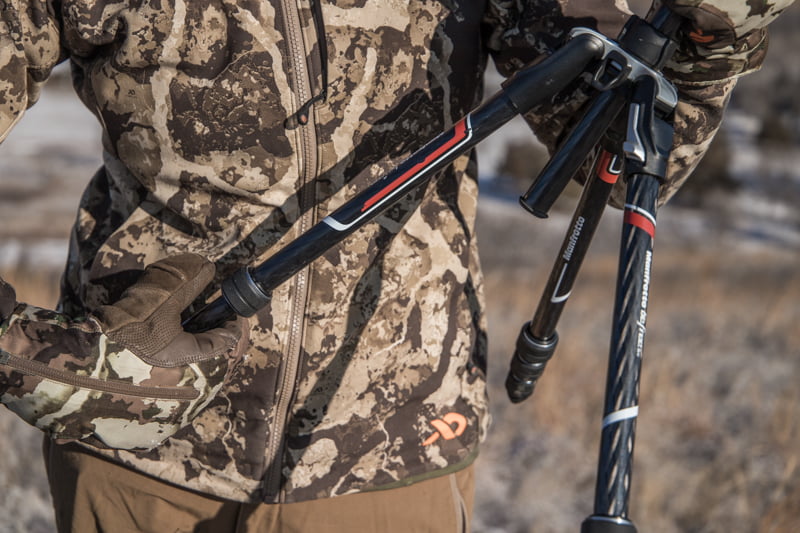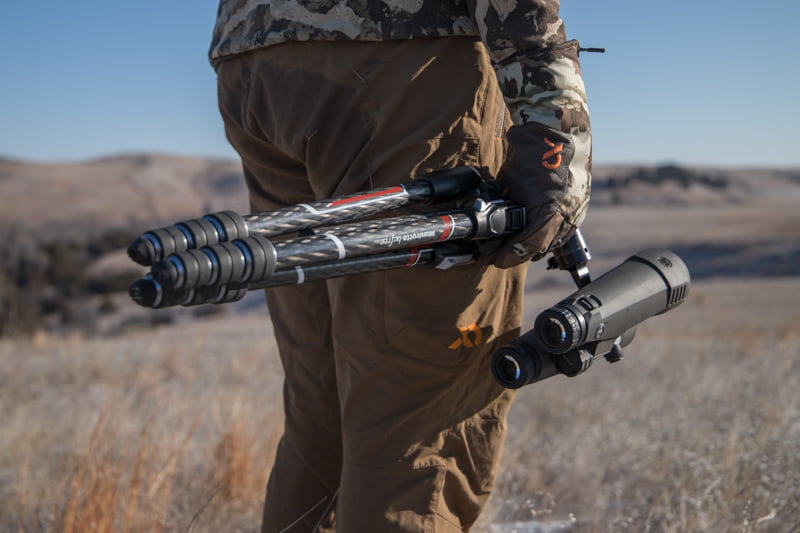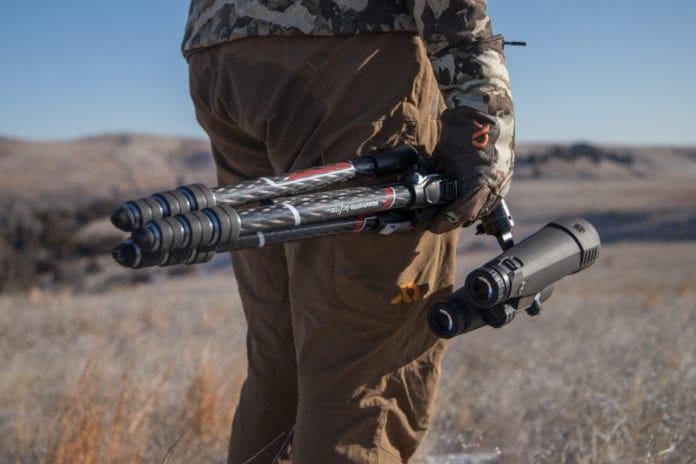
We all love glassing the backcountry. The thought of sitting on a peak gazing into a picture-perfect basin hoping to catch a buck feeding in the early morning really gets me excited. With my videography background, I realize the importance of a tripod for steady camera shots, and it’s no different with binoculars or a spotting scope. Recently I was given the opportunity from BlackOvis to review a Manfrotto tripod of my choice. After searching their site I decided to review the carbon fiber Manfrotto Befree Live tripod.
My Experience
I’ve been able to use a lot of tripods made of aluminum and carbon fiber. They ranged from light to heavy, and cheap to expensive. The Befree Live tripod and included Fluid Head come in at three pounds, but there’s something to be said for the sturdiness of a “heavier” tripod setup. An ultra-lightweight tripod, say sub-two pounds, is great to pack but can have a downfall in stability. High winds can cause havoc with ultralight systems, shaking your optics badly to where you might as well be handholding them. This can especially be an issue with spotting scopes at higher magnifications. A little heavier weight on the legs will increase stability.

BeFree Live Carbon Fiber Tripod
I welcomed everything about this tripod when it arrived. I’d used a couple of different Manfrotto carbon fiber tripod styles previously and both had been fairly bulky when it came to packing, but not this Befree model. The overall length packed is about 21 inches depending on the tripod head. Each leg has three sections that extend, giving the tripod a height of 51 inches with an extra 8 inches if you raise the center column. I’m 5 foot 10 inches and with both the legs and center column fully extended, I can glass standing up. However, I wouldn’t classify or recommend it as a standing tripod.
Leg Locks
The legs are a twist-lock design that is intuitive to use. One downside to twist locks is that they aren’t as simple to work on yourself if they were to malfunction in the field, whereas the alternate option of lever locks are typically easier. The knobs for the twist locks are large with a rubbery material that is tacky making them easy to get a hold of.

Quick Leveling Ball Joint
The tripod legs each have settings to change the angles of the legs to compensate for a side hill or to find a comfortable height while you’re sitting to glass. On the center column, where the fluid head attaches, there is a feature known as a ball joint. It’s like a half ball that the tripod head pivots on top of and is used for quick leveling of the head. For backcountry purposes, I think the ball joint adds more weight than it is worth but it can’t be taken off of this tripod.
Center Column
Another thing I’m not sold on, yet, is the center column tensioner design. Instead of the classic knob on the side, the tensioner is around the center column and functions by twisting similar to the twist-lock legs. It isn’t as intuitive as the side knob and can be difficult to get a good hold on with gloves, but seems to stay locked tight even with heavy optics.
Like I mentioned previously, the tripod did come with a Manfrotto Befree Fluid Head but I spent most of my time using the Outdoorsmans micro-pan head, dropping the total weight down about six ounces. The included Fluid Head would be plenty sufficient for any binocular and the typical spotting scope. If you plan on running big optics like the Swarovski BTX’s, Kowa’s or similar, take a look at the Outdoorsmans Fluid Head.

Field Testing
I used the tripod mostly during the late season in the midwest chasing whitetail and mule deer. I also used it on a cow elk hunt in Wyoming. The tripod folds up to a size I consider compact for sliding into a backpack. During those late seasons, I spent a lot of time glassing in high winds, and was overall pleased with the stability.
Towards the base of the tripod, there’s a little hook that can be used to hang things on for added weight, adding more stability. I used that hook a couple of times on the elk hunt with gusts to 40mph and it worked great with my pack hanging under it. There was still some vibration from the wind but the added weight made it bearable to glass. The rubber feet of the tripod legs are semi-aggressive and great if you’re glassing on rocks as the rubber grips the slick surface and prevents sliding.

You can purchase the carbon fiber Befree Live tripod and Fluid head for $349.99 from BlackOvis. Keep in mind that the inclusion of the Fluid Head is a $100 value.
Aluminum Option
Carbon fiber, in general, is more expensive than aluminum, so Black Ovis also carries the aluminum version of the Befree Live. It features the same Fluid Head and design as the carbon fiber version except the legs are made of aluminum. You will have a minor weight penalty for the material. But in return, it brings the cost down to $239.99 for the package. While I can’t comment on the Manfrotto warranty, BlackOvis is well known for going above and beyond with their customer service.

I was able to use the Befree Live for about three months and haven’t encountered a durability issue. This was used in cold weather, in and out of a pickup bed, strapped on a backpack and used hard. I can’t comment on the long-term durability, but the other Manfrotto tripods I have used long term have held up well. I would recommend the Manfrotto Befree Live carbon fiber tripod package to anyone in the market for a stable but packable tripod. Give BlackOvis a click to learn more
You can comment or ask Jordan questions here.




















